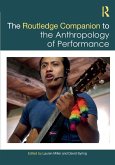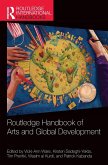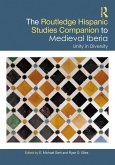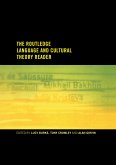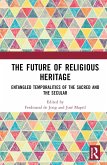The Routledge Handbook of Heritage and Gender
Herausgeber: Ashton, Jenna C.
The Routledge Handbook of Heritage and Gender
Herausgeber: Ashton, Jenna C.
- Gebundenes Buch
- Merkliste
- Auf die Merkliste
- Bewerten Bewerten
- Teilen
- Produkt teilen
- Produkterinnerung
- Produkterinnerung
The Routledge Handbook of Heritage and Gender offers an exceptional range of international contributions that interrogate and analyse the interactions within - and between - heritage and gender.
Andere Kunden interessierten sich auch für
![The Routledge Handbook of Museum and Heritage Education The Routledge Handbook of Museum and Heritage Education]() The Routledge Handbook of Museum and Heritage Education282,99 €
The Routledge Handbook of Museum and Heritage Education282,99 €![The Routledge Handbook of Cultural Landscape Heritage in The Asia-Pacific The Routledge Handbook of Cultural Landscape Heritage in The Asia-Pacific]() The Routledge Handbook of Cultural Landscape Heritage in The Asia-Pacific60,99 €
The Routledge Handbook of Cultural Landscape Heritage in The Asia-Pacific60,99 €![The Routledge Companion to the Anthropology of Performance The Routledge Companion to the Anthropology of Performance]() The Routledge Companion to the Anthropology of Performance61,99 €
The Routledge Companion to the Anthropology of Performance61,99 €![Routledge Handbook of Arts and Global Development Routledge Handbook of Arts and Global Development]() Routledge Handbook of Arts and Global Development257,99 €
Routledge Handbook of Arts and Global Development257,99 €![The Routledge Hispanic Studies Companion to Medieval Iberia The Routledge Hispanic Studies Companion to Medieval Iberia]() The Routledge Hispanic Studies Companion to Medieval Iberia304,99 €
The Routledge Hispanic Studies Companion to Medieval Iberia304,99 €![The Routledge Language and Cultural Theory Reader The Routledge Language and Cultural Theory Reader]() Lucy Burke / Tony Crowley / Alan Girvin (eds.)The Routledge Language and Cultural Theory Reader166,99 €
Lucy Burke / Tony Crowley / Alan Girvin (eds.)The Routledge Language and Cultural Theory Reader166,99 €![The Future of Religious Heritage The Future of Religious Heritage]() The Future of Religious Heritage148,99 €
The Future of Religious Heritage148,99 €-
-
-
The Routledge Handbook of Heritage and Gender offers an exceptional range of international contributions that interrogate and analyse the interactions within - and between - heritage and gender.
Produktdetails
- Produktdetails
- Verlag: Routledge
- Seitenzahl: 646
- Erscheinungstermin: 30. Mai 2025
- Englisch
- Abmessung: 250mm x 175mm x 39mm
- Gewicht: 1277g
- ISBN-13: 9781032192086
- ISBN-10: 1032192089
- Artikelnr.: 71775149
- Herstellerkennzeichnung
- Libri GmbH
- Europaallee 1
- 36244 Bad Hersfeld
- gpsr@libri.de
- Verlag: Routledge
- Seitenzahl: 646
- Erscheinungstermin: 30. Mai 2025
- Englisch
- Abmessung: 250mm x 175mm x 39mm
- Gewicht: 1277g
- ISBN-13: 9781032192086
- ISBN-10: 1032192089
- Artikelnr.: 71775149
- Herstellerkennzeichnung
- Libri GmbH
- Europaallee 1
- 36244 Bad Hersfeld
- gpsr@libri.de
Jenna C. Ashton is a Senior Lecturer in Heritage Studies, with a background in artmaking and writing, exhibition curation, creative producing, public engagement, and arts-education. Her multi-method and interdisciplinary research focuses on community-based practices, knowledges, economies, and critical literacies (also sometimes described as "living heritage" or "intangible cultural heritage"). Jenna's work sits across feminist environmental humanities and critical heritage studies. Previous edited collections include Feminism and Museums Vol 1: Intervention, Disruption and Change (2017), Feminism and Museums Vol 2: Intervention, Disruption and Change (2018), and Anonymous Was a Woman: A Museums and Feminism Reader (2020). Jenna is also the founder and Creative Director of the arts and heritage organisation Digital Women's Archive North (DWAN, 2015-), and creator of the 2017 manifesto, The Feminists Are Cackling in the Archive: A Manifesto for Feminist Archiving (or disruption).
List of Figures; List of Contributors; Introduction; PART 1: Materiality
and Performance of Gender - 1 Gendering Material Objects in Heritage
Practice; 2 Bridal Ornaments and Heritage Performances in India: The Case
of Kanchipuram Silk Saree and Temple Bridal Jewellery; 3 Queerly
Intersectional at the Dawn of Heritage Preservation: Judah Touro; 4 Women's
Stories Unheard in the Military Border Zone: Kitchen Storytelling as
Methodology; 5 Safeguarding Bulgarian Applied Folk Art : The Work of Helene
Oucheff; 6 The (Miss) Representation of Women in European Prehistory Museum
Displays: Breaking the Glass Display Case; PART 2: Gendered Heritage
Landscapes - 7 The Representation of Rosa Parks on the American Civil
Rights Memorial Landscape: 'Trapped on the Bus'; 8 Gender and Heritage at
Home at the Pankhurst Centre and Potter's Hill Top; 9 A Queer Manipulation
of the Sheats-Goldstein House: 'Quite a pad you got here, man'; 10
Contested Transcultural Spaces: The Mother Goddess Religion's Sacred Sites
and Rituals in Hü City, Vietnam; 11 Heritage Interpretation and
First-Person Narratives: Producing a Feminist Reading of Cultural
Landscapes; 12 An Ethnoarchaeology of Precolonial Gold Mining and the Role
of Women in Eastern Zimbabwe; 13 Industrial Archaeologies of Edna Lumb and
Angela Croome: Curating Aggregate; PART 3: Violence as Gender Heritage --
14 Sexual Violence in Premodern South Asian Literature: Unsavory Heritage;
15 Trauma, Memory, and Identity of Women in the Cambodia Diaspora; 16
Overwritten Memories: The Representation of Sexual Violence in the Arts and
Memory Space Fragmentos; 17 The Women behind the Door: The Casa de la
Memoria Kaji Tulam and the Reinterpretation of Guatemalan History; 18
Women's Monumental Activism: Statues That Matter; PART 4: Arts-led
Methodologies for Remembrance and Activation - 19 The Performative Legacies
of the Women's Peace Camp at Greenham Common: Beyond Monuments; 20 The
Illustrator in the Archive of Katie Gliddon; 21 Recovering the Excluded
Women in English Folk and Calendar Customs: Social Art as a Research
Methodology; 22 Mithila Folk Art: A Feminist Perspective; 23 Resisting
Orientalism Through Feminist Art in Turkey; 24 Doing Difficult Heritage,
Performing Diasporic Memory: Yoshiko Shimada and Haji Oh's Art of Affective
Recall; PART 5: Digital and Media Interventions for Gender Advocacy - 25
Confronting Gender Biases in Heritage Catalogues: A Natural Language
Processing Approach to Revisiting Descriptive Metadata; 26 Using Apps to
Promote Women Artists and Intervene in Gender Politics; 27 Intangible
Cultural Heritage, Gender, and Media: A Multimodal Content Analysis of the
UNESCO Nomination Films; 28 Autonomous Archives: Reframing Feminist
Heritage in the Context of COVID-19; PART 6: Nationhood, Politics, and
Gender - 29 Nordic Gender Ideals and the Viking Age: An Unresolved Legacy;
30 Feminist and Democratic Heritage: Lessons from Spain; 31 Gendered
Dimensions of Intangible Heritage in Europe: The Political Pasts and
Presents in Italy and Poland; 32 The politics of erasure and making
gendered heritage invisible in modern Iran; PART 7: Gender in Heritage
Leadership and Governance - 33 Gender as Frontstage Issue and Backstage
Problem in Current Museum Practices and Research; 34 A Gendered
Transnational Analysis of Future Heritage through National Museums'
Contemporary Art Collections: Mind the Gender Gap?; 35 Gender Perspectives
in the Governance of Cultural Heritage Institutions; PART 8: Futures of
Feminist and Queer Heritage - 36 The Uses of Queer Heritage; 37 Critical
Contexts and Proposals for a Feminist Heritage Studies and Feminist
Mnemopraxis; 38 Only wives and mothers? A transnational feminist
perspective on the representation of women in UNESCO's World Heritage
Convention and Convention for Safeguarding the Intangible Cultural
Heritage; 39 Interpretation of Cultural Heritage from a Gender Perspective:
The Women's Legacy White Paper Experience; 40 Development of Discourse on
the Intersection of Heritage and Gender within ICOMOS; Index.
and Performance of Gender - 1 Gendering Material Objects in Heritage
Practice; 2 Bridal Ornaments and Heritage Performances in India: The Case
of Kanchipuram Silk Saree and Temple Bridal Jewellery; 3 Queerly
Intersectional at the Dawn of Heritage Preservation: Judah Touro; 4 Women's
Stories Unheard in the Military Border Zone: Kitchen Storytelling as
Methodology; 5 Safeguarding Bulgarian Applied Folk Art : The Work of Helene
Oucheff; 6 The (Miss) Representation of Women in European Prehistory Museum
Displays: Breaking the Glass Display Case; PART 2: Gendered Heritage
Landscapes - 7 The Representation of Rosa Parks on the American Civil
Rights Memorial Landscape: 'Trapped on the Bus'; 8 Gender and Heritage at
Home at the Pankhurst Centre and Potter's Hill Top; 9 A Queer Manipulation
of the Sheats-Goldstein House: 'Quite a pad you got here, man'; 10
Contested Transcultural Spaces: The Mother Goddess Religion's Sacred Sites
and Rituals in Hü City, Vietnam; 11 Heritage Interpretation and
First-Person Narratives: Producing a Feminist Reading of Cultural
Landscapes; 12 An Ethnoarchaeology of Precolonial Gold Mining and the Role
of Women in Eastern Zimbabwe; 13 Industrial Archaeologies of Edna Lumb and
Angela Croome: Curating Aggregate; PART 3: Violence as Gender Heritage --
14 Sexual Violence in Premodern South Asian Literature: Unsavory Heritage;
15 Trauma, Memory, and Identity of Women in the Cambodia Diaspora; 16
Overwritten Memories: The Representation of Sexual Violence in the Arts and
Memory Space Fragmentos; 17 The Women behind the Door: The Casa de la
Memoria Kaji Tulam and the Reinterpretation of Guatemalan History; 18
Women's Monumental Activism: Statues That Matter; PART 4: Arts-led
Methodologies for Remembrance and Activation - 19 The Performative Legacies
of the Women's Peace Camp at Greenham Common: Beyond Monuments; 20 The
Illustrator in the Archive of Katie Gliddon; 21 Recovering the Excluded
Women in English Folk and Calendar Customs: Social Art as a Research
Methodology; 22 Mithila Folk Art: A Feminist Perspective; 23 Resisting
Orientalism Through Feminist Art in Turkey; 24 Doing Difficult Heritage,
Performing Diasporic Memory: Yoshiko Shimada and Haji Oh's Art of Affective
Recall; PART 5: Digital and Media Interventions for Gender Advocacy - 25
Confronting Gender Biases in Heritage Catalogues: A Natural Language
Processing Approach to Revisiting Descriptive Metadata; 26 Using Apps to
Promote Women Artists and Intervene in Gender Politics; 27 Intangible
Cultural Heritage, Gender, and Media: A Multimodal Content Analysis of the
UNESCO Nomination Films; 28 Autonomous Archives: Reframing Feminist
Heritage in the Context of COVID-19; PART 6: Nationhood, Politics, and
Gender - 29 Nordic Gender Ideals and the Viking Age: An Unresolved Legacy;
30 Feminist and Democratic Heritage: Lessons from Spain; 31 Gendered
Dimensions of Intangible Heritage in Europe: The Political Pasts and
Presents in Italy and Poland; 32 The politics of erasure and making
gendered heritage invisible in modern Iran; PART 7: Gender in Heritage
Leadership and Governance - 33 Gender as Frontstage Issue and Backstage
Problem in Current Museum Practices and Research; 34 A Gendered
Transnational Analysis of Future Heritage through National Museums'
Contemporary Art Collections: Mind the Gender Gap?; 35 Gender Perspectives
in the Governance of Cultural Heritage Institutions; PART 8: Futures of
Feminist and Queer Heritage - 36 The Uses of Queer Heritage; 37 Critical
Contexts and Proposals for a Feminist Heritage Studies and Feminist
Mnemopraxis; 38 Only wives and mothers? A transnational feminist
perspective on the representation of women in UNESCO's World Heritage
Convention and Convention for Safeguarding the Intangible Cultural
Heritage; 39 Interpretation of Cultural Heritage from a Gender Perspective:
The Women's Legacy White Paper Experience; 40 Development of Discourse on
the Intersection of Heritage and Gender within ICOMOS; Index.
List of Figures; List of Contributors; Introduction; PART 1: Materiality
and Performance of Gender - 1 Gendering Material Objects in Heritage
Practice; 2 Bridal Ornaments and Heritage Performances in India: The Case
of Kanchipuram Silk Saree and Temple Bridal Jewellery; 3 Queerly
Intersectional at the Dawn of Heritage Preservation: Judah Touro; 4 Women's
Stories Unheard in the Military Border Zone: Kitchen Storytelling as
Methodology; 5 Safeguarding Bulgarian Applied Folk Art : The Work of Helene
Oucheff; 6 The (Miss) Representation of Women in European Prehistory Museum
Displays: Breaking the Glass Display Case; PART 2: Gendered Heritage
Landscapes - 7 The Representation of Rosa Parks on the American Civil
Rights Memorial Landscape: 'Trapped on the Bus'; 8 Gender and Heritage at
Home at the Pankhurst Centre and Potter's Hill Top; 9 A Queer Manipulation
of the Sheats-Goldstein House: 'Quite a pad you got here, man'; 10
Contested Transcultural Spaces: The Mother Goddess Religion's Sacred Sites
and Rituals in Hü City, Vietnam; 11 Heritage Interpretation and
First-Person Narratives: Producing a Feminist Reading of Cultural
Landscapes; 12 An Ethnoarchaeology of Precolonial Gold Mining and the Role
of Women in Eastern Zimbabwe; 13 Industrial Archaeologies of Edna Lumb and
Angela Croome: Curating Aggregate; PART 3: Violence as Gender Heritage --
14 Sexual Violence in Premodern South Asian Literature: Unsavory Heritage;
15 Trauma, Memory, and Identity of Women in the Cambodia Diaspora; 16
Overwritten Memories: The Representation of Sexual Violence in the Arts and
Memory Space Fragmentos; 17 The Women behind the Door: The Casa de la
Memoria Kaji Tulam and the Reinterpretation of Guatemalan History; 18
Women's Monumental Activism: Statues That Matter; PART 4: Arts-led
Methodologies for Remembrance and Activation - 19 The Performative Legacies
of the Women's Peace Camp at Greenham Common: Beyond Monuments; 20 The
Illustrator in the Archive of Katie Gliddon; 21 Recovering the Excluded
Women in English Folk and Calendar Customs: Social Art as a Research
Methodology; 22 Mithila Folk Art: A Feminist Perspective; 23 Resisting
Orientalism Through Feminist Art in Turkey; 24 Doing Difficult Heritage,
Performing Diasporic Memory: Yoshiko Shimada and Haji Oh's Art of Affective
Recall; PART 5: Digital and Media Interventions for Gender Advocacy - 25
Confronting Gender Biases in Heritage Catalogues: A Natural Language
Processing Approach to Revisiting Descriptive Metadata; 26 Using Apps to
Promote Women Artists and Intervene in Gender Politics; 27 Intangible
Cultural Heritage, Gender, and Media: A Multimodal Content Analysis of the
UNESCO Nomination Films; 28 Autonomous Archives: Reframing Feminist
Heritage in the Context of COVID-19; PART 6: Nationhood, Politics, and
Gender - 29 Nordic Gender Ideals and the Viking Age: An Unresolved Legacy;
30 Feminist and Democratic Heritage: Lessons from Spain; 31 Gendered
Dimensions of Intangible Heritage in Europe: The Political Pasts and
Presents in Italy and Poland; 32 The politics of erasure and making
gendered heritage invisible in modern Iran; PART 7: Gender in Heritage
Leadership and Governance - 33 Gender as Frontstage Issue and Backstage
Problem in Current Museum Practices and Research; 34 A Gendered
Transnational Analysis of Future Heritage through National Museums'
Contemporary Art Collections: Mind the Gender Gap?; 35 Gender Perspectives
in the Governance of Cultural Heritage Institutions; PART 8: Futures of
Feminist and Queer Heritage - 36 The Uses of Queer Heritage; 37 Critical
Contexts and Proposals for a Feminist Heritage Studies and Feminist
Mnemopraxis; 38 Only wives and mothers? A transnational feminist
perspective on the representation of women in UNESCO's World Heritage
Convention and Convention for Safeguarding the Intangible Cultural
Heritage; 39 Interpretation of Cultural Heritage from a Gender Perspective:
The Women's Legacy White Paper Experience; 40 Development of Discourse on
the Intersection of Heritage and Gender within ICOMOS; Index.
and Performance of Gender - 1 Gendering Material Objects in Heritage
Practice; 2 Bridal Ornaments and Heritage Performances in India: The Case
of Kanchipuram Silk Saree and Temple Bridal Jewellery; 3 Queerly
Intersectional at the Dawn of Heritage Preservation: Judah Touro; 4 Women's
Stories Unheard in the Military Border Zone: Kitchen Storytelling as
Methodology; 5 Safeguarding Bulgarian Applied Folk Art : The Work of Helene
Oucheff; 6 The (Miss) Representation of Women in European Prehistory Museum
Displays: Breaking the Glass Display Case; PART 2: Gendered Heritage
Landscapes - 7 The Representation of Rosa Parks on the American Civil
Rights Memorial Landscape: 'Trapped on the Bus'; 8 Gender and Heritage at
Home at the Pankhurst Centre and Potter's Hill Top; 9 A Queer Manipulation
of the Sheats-Goldstein House: 'Quite a pad you got here, man'; 10
Contested Transcultural Spaces: The Mother Goddess Religion's Sacred Sites
and Rituals in Hü City, Vietnam; 11 Heritage Interpretation and
First-Person Narratives: Producing a Feminist Reading of Cultural
Landscapes; 12 An Ethnoarchaeology of Precolonial Gold Mining and the Role
of Women in Eastern Zimbabwe; 13 Industrial Archaeologies of Edna Lumb and
Angela Croome: Curating Aggregate; PART 3: Violence as Gender Heritage --
14 Sexual Violence in Premodern South Asian Literature: Unsavory Heritage;
15 Trauma, Memory, and Identity of Women in the Cambodia Diaspora; 16
Overwritten Memories: The Representation of Sexual Violence in the Arts and
Memory Space Fragmentos; 17 The Women behind the Door: The Casa de la
Memoria Kaji Tulam and the Reinterpretation of Guatemalan History; 18
Women's Monumental Activism: Statues That Matter; PART 4: Arts-led
Methodologies for Remembrance and Activation - 19 The Performative Legacies
of the Women's Peace Camp at Greenham Common: Beyond Monuments; 20 The
Illustrator in the Archive of Katie Gliddon; 21 Recovering the Excluded
Women in English Folk and Calendar Customs: Social Art as a Research
Methodology; 22 Mithila Folk Art: A Feminist Perspective; 23 Resisting
Orientalism Through Feminist Art in Turkey; 24 Doing Difficult Heritage,
Performing Diasporic Memory: Yoshiko Shimada and Haji Oh's Art of Affective
Recall; PART 5: Digital and Media Interventions for Gender Advocacy - 25
Confronting Gender Biases in Heritage Catalogues: A Natural Language
Processing Approach to Revisiting Descriptive Metadata; 26 Using Apps to
Promote Women Artists and Intervene in Gender Politics; 27 Intangible
Cultural Heritage, Gender, and Media: A Multimodal Content Analysis of the
UNESCO Nomination Films; 28 Autonomous Archives: Reframing Feminist
Heritage in the Context of COVID-19; PART 6: Nationhood, Politics, and
Gender - 29 Nordic Gender Ideals and the Viking Age: An Unresolved Legacy;
30 Feminist and Democratic Heritage: Lessons from Spain; 31 Gendered
Dimensions of Intangible Heritage in Europe: The Political Pasts and
Presents in Italy and Poland; 32 The politics of erasure and making
gendered heritage invisible in modern Iran; PART 7: Gender in Heritage
Leadership and Governance - 33 Gender as Frontstage Issue and Backstage
Problem in Current Museum Practices and Research; 34 A Gendered
Transnational Analysis of Future Heritage through National Museums'
Contemporary Art Collections: Mind the Gender Gap?; 35 Gender Perspectives
in the Governance of Cultural Heritage Institutions; PART 8: Futures of
Feminist and Queer Heritage - 36 The Uses of Queer Heritage; 37 Critical
Contexts and Proposals for a Feminist Heritage Studies and Feminist
Mnemopraxis; 38 Only wives and mothers? A transnational feminist
perspective on the representation of women in UNESCO's World Heritage
Convention and Convention for Safeguarding the Intangible Cultural
Heritage; 39 Interpretation of Cultural Heritage from a Gender Perspective:
The Women's Legacy White Paper Experience; 40 Development of Discourse on
the Intersection of Heritage and Gender within ICOMOS; Index.




